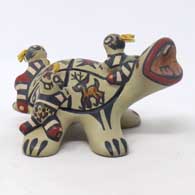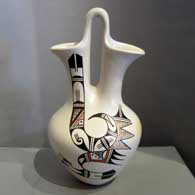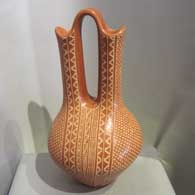
Margaret and Luther Gutierrez, Santa Clara, Polychrome wedding vase corn holder and eagle design
Margaret and Luther Gutierrez
Santa Clara
$ 1850
aasc2e382
Polychrome wedding vase corn holder and eagle design
6.25 in L by 9.75 in W 11 in H
Condition: Very Good
Signature: Margaret / Luther Santa Clara Pueblo
Santa Clara
$ 1850
aasc2e382
Polychrome wedding vase corn holder and eagle design
6.25 in L by 9.75 in W 11 in H
Condition: Very Good
Signature: Margaret / Luther Santa Clara Pueblo
100 West San Francisco Street, Santa Fe, New Mexico 87501
(505) 986-1234 - www.andreafisherpottery.com - All Rights Reserved
(505) 986-1234 - www.andreafisherpottery.com - All Rights Reserved
Gutierrez Family Tree
Disclaimer: This "family tree" is a best effort on our part to determine who the potters are in this family and arrange them in a generational order. The general information available is questionable so we have tried to show each of these diagrams to living members of each family to get their input and approval, too. This diagram is subject to change should we get better info.
- Jose Domingo Gutierrez (1844-before 1931) and Tonita Gutierrez (1859-aft 1934)
- Lela (1895-1966) & Van (Evangelio) Gutierrez (1885-1956)
- Luther Gutierrez (1911-1987) & Lupita Naranjo
- Paul & Dorothy (Navajo) Gutierrez
- Gary Gutierrez
- Paul Gutierrez Jr. (1966-)
- Pauline Gutierrez Naranjo (1931-)
- Stephanie Naranjo (1960-)
- Paul & Dorothy (Navajo) Gutierrez
- Margaret Rose Gutierrez (1936-2018)
- Luther Gutierrez (1911-1987) & Lupita Naranjo
- Severa Gutierrez Tafoya (1890-1973) and Cleto Tafoya
- Angela Tafoya Baca (1927-2014) & Antonio Baca
- Alvin Baca (1966-)
- David Baca (1951-)
- Epimenia (Mela) Tafoya (1920-1962) & Robert Nichols
- Robert Cleto Nichols (1961-) & Miana Pablito (Zuni)
- Lydia Tafoya (1923-1975) & Santiago Garcia (San Juan/Ohkay Owingeh)
- Greg Garcia (1961-2010)
- Tina Garcia (1957-2005)
- Virginia Garcia (1963-)
- Maria (Mary Agnes) Tafoya (1925-1983) & Mosimino Tafoya
- Gwen Tafoya
- Wanda Tafoya (1950-)
- Eric Tafoya (1969-)
- Tonita (1930-) & Paul Tafoya
- Paul Speckled Rock (1952-2017)
- Adam Speckled Rock (1972-)
- Kenneth Tafoya (1953-)
- Ray Tafoya (1956-1995) & Emily (Suazo) Tafoya
- Jennifer (Tafoya) Moquino (1977-) & Michael Moquino
- Paul Speckled Rock (1952-2017)
- Angela Tafoya Baca (1927-2014) & Antonio Baca
Some of the above info is drawn from Pueblo Indian Pottery, 750 Artist Biographies, by Gregory Schaaf, © 2000, Center for Indigenous Arts & Studies. Other info is derived from personal contacts with family members and through interminable searches of the Internet.










